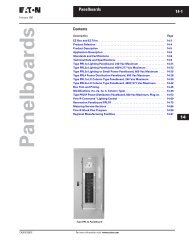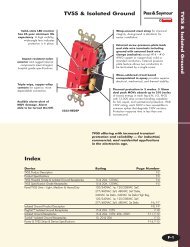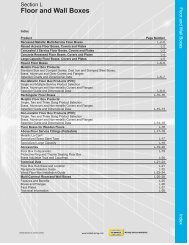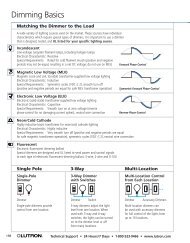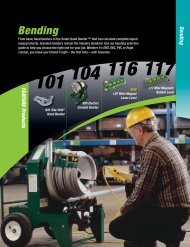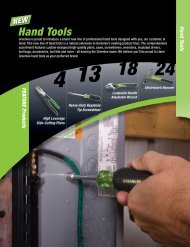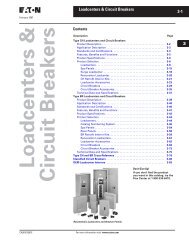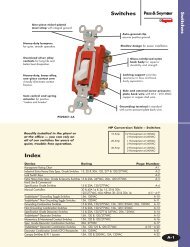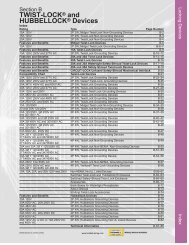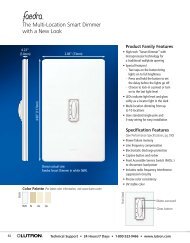- Page 2 and 3:
Leviton Celebrates 100 Years As A L
- Page 5:
TABLE OF CONTENTS with Quick Refere
- Page 8:
Leviton…Building a Connected Worl
- Page 11 and 12:
ISO 9001 Certified Quality Manufact
- Page 13 and 14:
SECTIONAAcenti CollectionPremium Gr
- Page 15 and 16:
ACENTI ® LIGHTING CONTROLS • 400
- Page 17 and 18:
Acenti ReceptaclesAcenti Triplex an
- Page 19 and 20:
SECTIONBDecora ® DevicesGeneral Ov
- Page 21 and 22:
DECORA ® PLUS DEVICE FEATURESComme
- Page 23 and 24:
DECORA ® PLUS SWITCHES 15 AMP 120/
- Page 26 and 27:
DECORA ® SWITCHES15 AMP 120 and 12
- Page 28 and 29:
DECORA ® PLUS RECEPTACLES 15 and 2
- Page 30 and 31:
DECORA ® RECEPTACLES 15 AMP 125VRe
- Page 32 and 33:
DECORA ® SMARTLOCK ® GFCI PERSONN
- Page 34 and 35:
DECORA ® COMBINATION DEVICES 15 an
- Page 36 and 37:
DECORA ® VOICE, DATA and VIDEO DEV
- Page 38 and 39:
DECORA ® PLUS SCREWLESS SNAP-ON WA
- Page 40 and 41:
DECORA ® WALLPLATESResidential and
- Page 42 and 43:
DECORA ® WALLPLATE ACCESSORIESResi
- Page 44 and 45:
ELEMENTS by DECORA ® DEVICESReside
- Page 46 and 47:
DIMENSIONS ARCHITECTURAL LIGHTING
- Page 48 and 49:
DIMENSIONS ARCHITECTURAL LIGHTING
- Page 50 and 51:
DIMENSIONS ARCHITECTURAL LIGHTING
- Page 52 and 53:
POWER EXTENDERS for ARCHITECTURAL L
- Page 54 and 55:
ARCHITECTURAL SPECIFICATIONS LIGHTI
- Page 56 and 57:
MONET ® LIGHTING CONTROLS • 20 A
- Page 58 and 59:
RENOIR ® LIGHTING CONTROLS • 800
- Page 60 and 61:
VAN GOGH ® LIGHTING CONTROLS • 8
- Page 62 and 63:
MURAL ® LIGHTING CONTROL FEATURESC
- Page 64 and 65:
MURAL ® LIGHTING CONTROLS • 600-
- Page 66 and 67:
MURAL ® SCENE CONTROLS • NO LOAD
- Page 68 and 69:
TOUCHPOINT LIGHTING CONTROLS • 6
- Page 70 and 71:
TOGGLETOUCH LIGHTING CONTROLS •
- Page 72 and 73:
ILLUMATECH LIGHTING CONTROLS • 6
- Page 74 and 75:
ILLUMATECH LIGHTING CONTROLS • 6
- Page 76 and 77:
TRIMATRON LIGHTING CONTROLS • 60
- Page 78 and 79:
INCANDESCENT LIGHTING CONTROLS •
- Page 80 and 81:
OCCUPANCY SENSOR LIGHTING CONTROL F
- Page 82 and 83:
DECORA ® OCCUPANCY SENSOR LIGHTING
- Page 84 and 85:
OCCUPANCY SENSOR LIGHTING CONTROLS
- Page 86 and 87:
OCCUPANCY SENSOR LIGHTING CONTROLS
- Page 88 and 89:
5.50 (139.7)4.12(104.6)OCCUPANCY SE
- Page 90 and 91:
OCCUPANCY SENSOR LIGHTING CONTROLS
- Page 92 and 93:
FLUORESCENT ENERGY MANAGEMENT SYSTE
- Page 94 and 95:
DECORA ® ELECTRONIC TIMER SWITCHES
- Page 96 and 97:
HOW TO USE THIS CATALOGThe L-100 Le
- Page 98 and 99:
DECORA ® PLUS SCREWLESS SNAP-ON WA
- Page 100 and 101:
DecoraWALLPLATESResidential and Com
- Page 102 and 103:
LARGER SIZE WALLPLATESResidential a
- Page 104 and 105:
WALLPLATESResidential and Commercia
- Page 106 and 107:
WALLPLATESResidential and Commercia
- Page 108 and 109:
WALLPLATESResidential and Commercia
- Page 110 and 111:
WALLPLATESResidential and Commercia
- Page 112 and 113:
WALLPLATESResidential and Commercia
- Page 114 and 115:
WALLPLATESResidential and Commercia
- Page 116 and 117:
WALLPLATESResidential and Commercia
- Page 118 and 119:
WALLPLATESResidential and Commercia
- Page 120 and 121:
WALLPLATESResidential and Commercia
- Page 122 and 123:
WALLPLATESResidential and Commercia
- Page 124 and 125:
WALLPLATESResidential and Commercia
- Page 126 and 127:
ENGRAVED WALLPLATESResidential and
- Page 128 and 129:
WEATHER-RESISTANT COVERSCommercial
- Page 130 and 131:
WEATHER-RESISTANT COVERSIndustrial
- Page 132 and 133:
WALLPLATE ACCESSORIESCommercial Gra
- Page 134 and 135:
WALLPLATESHow to Order Custom Wallp
- Page 136 and 137:
WALLPLATESHow to Order Custom Wallp
- Page 138 and 139:
AC SWITCH FEATURESIndustrial Grade
- Page 140 and 141:
15, 20 and 30 AMP 120V and 20 AMP 2
- Page 142 and 143:
15 and 20 AMP 120/277VIndustrial Gr
- Page 144 and 145:
SAFETY DISCONNECT SWITCH FEATURESIn
- Page 146 and 147:
20 AMP 120/277VIndustrial Grade AC
- Page 148 and 149:
15 and 20 AMP 120/277V • 15 and 2
- Page 150 and 151:
15 AMP 120VResidential Grade AC Qui
- Page 152 and 153:
STRAIGHT BLADE RECEPTACLE FEATURESI
- Page 154 and 155:
15 AMP 125 and 250V • 20 AMP 125
- Page 156 and 157:
20 AMP 120/208V • 30 AMP 125VIndu
- Page 158 and 159:
30 AMP 125/250V • 30 AMP 250V 3Ø
- Page 160 and 161:
W50 AMP 125/250 and 250V 3ØIndustr
- Page 162 and 163:
STRAIGHT BLADE RECEPTACLE FEATURESC
- Page 164 and 165:
15 AMP 125 and 250V • 20 AMP 125
- Page 166 and 167:
15 AMP 125V • 15 AMP 125V CO/ALRR
- Page 168 and 169:
HOW TO USE THIS CATALOGThe L-100 Le
- Page 170 and 171:
SMARTLOCK ® GFCI PERSONNEL PROTECT
- Page 172 and 173:
15 AMP 125V • 20 AMP 125VCommerci
- Page 174 and 175:
15 and 20 AMP 125V • 15 and 20 AM
- Page 176 and 177:
HOW TO USE THIS CATALOGThe L-100 Le
- Page 178 and 179:
15 and 20 AMP 120V and 120/277VComm
- Page 180 and 181:
15 AMP 120VCommercial Grade AC Comb
- Page 182 and 183:
STRUCTURED MEDIA COMPONENTSSTRUCTUR
- Page 184 and 185:
STRUCTURED MEDIA CENTERSStructured
- Page 186 and 187:
STRUCTURED MEDIA CENTERSStructured
- Page 188 and 189:
SECURITYFROM DEMARCATIONONFROM DEMA
- Page 190 and 191:
STRUCTURED MEDIA PANELS and BOARDS
- Page 192 and 193:
STRUCTURED MEDIA BRACKETSABStructu
- Page 194 and 195:
MEDIA CENTER POWERStructured Media
- Page 196 and 197:
VIDEO DISTRIBUTIONStructured Media
- Page 198 and 199:
VIDEO DISTRIBUTIONStructured Media
- Page 200 and 201:
HOME SECURITY MONITORINGStructured
- Page 202 and 203:
MULTI-ROOM AUDIO/VIDEOACBMulti-Room
- Page 204 and 205:
MULTI-ROOM AUDIO/VIDEO DISTRIBUTION
- Page 206 and 207:
MULTI-LOCATION AUDIOComposer Series
- Page 208 and 209:
MULTI-LOCATION AUDIOSpecialized Aud
- Page 210 and 211:
LEVITON ENTERTAINMENT and APPLICATI
- Page 212 and 213:
DHC POWERLINE CARRIER COMPONENTS FE
- Page 214 and 215:
DECORA ® HOME CONTROLS (DHC)Reside
- Page 216 and 217:
DECORA ® HOME CONTROLS (DHC)Reside
- Page 218 and 219:
DECORA ® HOME CONTROLS (DHC)Reside
- Page 220 and 221:
DECORA ® HOME CONTROLS (DHC)Reside
- Page 222 and 223:
DECORA ® HOME CONTROLS (DHC)Reside
- Page 224 and 225:
DECORA ® HOME CONTROLS (DHC)Reside
- Page 226 and 227:
DECORA ® HOME CONTROLS (DHC)Reside
- Page 228 and 229:
HOW TO USE THIS CATALOGThe L-100 Le
- Page 230 and 231:
MULTIMEDIA STRUCTURED CABLING DEVIC
- Page 232 and 233:
QUICKPORT ® SNAP-IN for AUDIO/VIDE
- Page 234 and 235:
FIBER OPTIC CONNECTORSFiber Optic C
- Page 236 and 237:
CONNECTOR BEZELSABConnector Interfa
- Page 238 and 239:
QUICKPORT ® DECORA ® MULTIMEDIA I
- Page 240 and 241:
QUICKPORT ® STAINLESS STEEL WALLPL
- Page 242 and 243:
QUICKPORT ® MULTIMEDIA OUTLET SYST
- Page 244 and 245:
QUICKPORT ® SURFACE MOUNT HOUSINGS
- Page 246 and 247:
ACENTI and STANDARD WALLPLATESWall
- Page 248 and 249:
TELEPHONE INSERT WALL JACKSABDecora
- Page 250 and 251:
TELEPHONE WALL JACK INSERTSWallplat
- Page 252 and 253:
WORKSTATION ACCESSORIESACBDWorkstat
- Page 254 and 255:
CUSPATCH PANELS and BLOCKSSUNIVERSA
- Page 256 and 257:
ANGLED PATCH PANELSSCopper Componen
- Page 258 and 259:
PATCH CORDS and RACK & PANEL ACCESS
- Page 260 and 261:
EXTREME ® 6+ 110-STYLE PATCH CORDS
- Page 262 and 263:
RACK-MOUNT 110-STYLE WIRING PRODUCT
- Page 264 and 265:
110-STYLE WALL-MOUNT FRAMESSCopper
- Page 266 and 267:
66-CONNECTING BLOCK ACCESSORIES66-C
- Page 268 and 269:
OPT-X ® 1000 1RU FIBER OPTIC ENCLO
- Page 270 and 271:
OPT-X ® 1000 3RU and 6RU FIBER OPT
- Page 272 and 273:
OPT-X ® 500 and OPT-X ® 250 FIBER
- Page 274 and 275:
FIBER OPTIC ACCESSORIESLoaded:ABCDE
- Page 276 and 277:
FIBER OPTIC ACCESSORIESGEFBACDFiber
- Page 278 and 279:
PASSIVE ZONE CABLINGTelecommunicati
- Page 280 and 281:
VERSI-DUCT CABLE MANAGEMENT SYSTEM
- Page 282 and 283:
RACK CABLE MANAGEMENT and ACCESSORI
- Page 284 and 285:
GENERAL PURPOSE HOOK & LOOP CABLE M
- Page 286 and 287:
LABELING PRODUCTS and ACCESSORIESAB
- Page 288 and 289:
OPT-X ® FIBER TOOLSTools and Acces
- Page 290 and 291:
TOOLS and ACCESSORIESAComes with a
- Page 292 and 293:
TOOLS and ACCESSORIESACraftsperson
- Page 294 and 295:
STRAIGHT BLADE PLUG AND CONNECTOR F
- Page 296 and 297:
20 AMP 125 and 250VIndustrial Grade
- Page 298 and 299:
15 AMP 125 and 250V • 20 AMP 125
- Page 300 and 301:
20 AMP 125/250 and 120/208V • 30
- Page 302 and 303:
60 AMP 250, 125/250 and 120/208VInd
- Page 304 and 305:
15 AMP 125 and 250VCommercial Grade
- Page 306 and 307:
30 AMP—125V/50 AMP 125V, 250V/50
- Page 308 and 309:
15 AMP 125VResidential Grade Straig
- Page 310 and 311:
LOCKING DEVICE FEATURESIndustrial G
- Page 312 and 313:
WETGUARD ® LOCKING AND CORROSION R
- Page 314 and 315:
15 AMP 250V, 277V and 3Ø 250VIndus
- Page 316 and 317:
20 AMP 347V, 480V, 600V and 125/250
- Page 318 and 319:
20 AMP 3Ø 480V; 3ØY 120/208V, 277
- Page 320 and 321:
30 AMP 125V, 250V and 277VIndustria
- Page 322 and 323:
30 AMP 3Ø 480V, 3Ø 600V, 3Ø 250V
- Page 324 and 325:
30 AMP 3ØY 347/600V, 3ØY 120/208V
- Page 326 and 327:
20 AMP 125/250V; 3Ø 250V, 480V, 3
- Page 328 and 329:
15 AMP 125V, 250V and 277VIndustria
- Page 330 and 331:
30 AMP 125V, 250V, 125/250V and 3Ø
- Page 332 and 333:
15 AMP 125V/10A-250; 20 AMP 250V, 1
- Page 334 and 335:
50 AMP 125V, 250V, 125/250V, 480V a
- Page 336 and 337:
20 AMP 125V and 30A-600VAC / 20 AMP
- Page 338 and 339:
COMBINATION LOCKING & STRAIGHT BLAD
- Page 340 and 341:
Pin & Sleeve DevicesPIN & SLEEVE DE
- Page 342 and 343:
20 AMP • 30 AMPIndustrial Grade N
- Page 344 and 345:
PLUG & CONNECTOR DIMENSIONSIndustri
- Page 346 and 347:
TECHNICAL INFORMATIONIndustrial Gra
- Page 348 and 349:
MECHANICAL INTERLOCK FEATURESIndust
- Page 350 and 351:
20 AMP • 30 AMPIndustrial Grade N
- Page 352 and 353:
MECHANICAL INTERLOCK DIMENSIONSIndu
- Page 354 and 355:
16 AMP • 32 AMP • 63 AMP • 12
- Page 356 and 357:
PLUG & CONNECTOR DIMENSIONSIndustri
- Page 358 and 359:
INLET & RECEPTACLE DIMENSIONSIndust
- Page 360 and 361:
PIN & SLEEVE ACCESSORIESIndustrial
- Page 362 and 363:
SAFETY DISCONNECT SWITCH FEATURESIn
- Page 364 and 365:
TECHNICAL INFORMATIONIndustrial Gra
- Page 366 and 367:
SAFETY DISCONNECT SWITCH DIMENSIONS
- Page 368 and 369:
STAGE PIN DEVICE FEATURESCommercial
- Page 370 and 371:
SINGLE POLE CAM-TYPE CONNECTOR FEAT
- Page 372 and 373:
SINGLE POLE CAM-TYPE AMPACITY CHART
- Page 374 and 375:
16 SERIES—TAPER NOSE—UP TO 300
- Page 376 and 377:
16 SERIES—TAPER NOSE—UP TO 400
- Page 378 and 379:
18 SERIES—BALL NOSE—UP TO 400 A
- Page 380 and 381:
17 SERIES—TAPER NOSE—UP TO 690
- Page 382 and 383:
22 SERIES—LATCHING BALL NOSE—UP
- Page 384 and 385:
SINGLE POLE CAM-TYPE CONNECTORS—P
- Page 386 and 387:
STAGE PIN PANEL MOUNT—DIMENSIONED
- Page 388 and 389:
SINGLE POLE CAM-TYPE CONNECTORS—D
- Page 390 and 391:
SINGLE POLE CAM-TYPE CONNECTORS—D
- Page 392 and 393:
SINGLE POLE CAM-TYPE CONNECTORS—D
- Page 394 and 395:
WIRE MESH SAFETY GRIP FEATURESIndus
- Page 396 and 397:
WIRE MESH SAFETY GRIP SELECTIONIndu
- Page 398 and 399:
WIRE MESH SAFETY GRIP SELECTIONIndu
- Page 400 and 401:
WIRE MESH PULLING GRIPSIndustrial G
- Page 402 and 403:
WIRE MESH PULLING GRIPSIndustrial G
- Page 404 and 405:
WIRE MESH PULLING GRIPSIndustrial G
- Page 406 and 407:
WIRE MESH PULLING GRIPSIndustrial G
- Page 408 and 409:
WIRE MESH STRAIN-RELIEF GRIP DIMENS
- Page 410 and 411:
WIRE MESH STRAIN-RELIEF GRIPSIndust
- Page 412 and 413:
WIRE MESH SUPPORT GRIPSIndustrial G
- Page 414 and 415:
WIRE MESH SUPPORT GRIPSIndustrial G
- Page 416 and 417:
WIRE MESH SUPPORT GRIPSIndustrial G
- Page 418 and 419:
WIRE MESH SUPPORT GRIPSIndustrial G
- Page 420 and 421:
SURGE PROTECTIVE DEVICE FEATURESInd
- Page 422 and 423:
PLUG STRIPSIndustrial Grade Surge P
- Page 424 and 425:
PANEL MOUNT DEVICESIndustrial Grade
- Page 426 and 427:
PANEL MOUNT DEVICESIndustrial Grade
- Page 428 and 429:
MULTI-PHASE PANEL PROTECTORSIndustr
- Page 430 and 431:
EQUIPMENT CABINET SURGE PROTECTIONI
- Page 432 and 433:
FOUR-IN-ONE SURGE PROTECTIVE RECEPT
- Page 434 and 435:
PLUG-IN SURGE PROTECTIVE DEVICESCom
- Page 436 and 437:
METER SOCKET SURGE ADAPTER and SECO
- Page 438 and 439:
MODULAR SURGE PROTECTIVE STRIPSResi
- Page 440 and 441: POWER QUALITYCommercial Grade Unint
- Page 442 and 443: LAMPHOLDERSA VARIETY OF INCANDESCEN
- Page 444 and 445: 660W 125V — 15 AMP-125VMedium Bas
- Page 446 and 447: 660W 250VMedium, Candelabra Base, P
- Page 448 and 449: 660W 250V • 1500W 600VMedium, Mog
- Page 450 and 451: 660W 600V • 660W 250V • 250W 25
- Page 452 and 453: 75W 125V • 660W 250VCandelabra an
- Page 454 and 455: 660W 600V • 660W 1000V • 75W 25
- Page 456 and 457: 120W 600V • 660W 600VMedium and M
- Page 458 and 459: LAMP SUPPORT CLIPSLamp Support Clip
- Page 460 and 461: 75W 600VCompact Fluorescent Lamphol
- Page 462 and 463: 75W 600VCompact Fluorescent Lamphol
- Page 464 and 465: 3 AMP 125V • 6 AMP 125VCommercial
- Page 466 and 467: 40 WATT 125V • 6 AMP 125V • 8 A
- Page 468 and 469: HOW TO USE THIS CATALOGThe L-100 Le
- Page 470 and 471: 15 AMP 125V ADAPTERSResidential Gra
- Page 472 and 473: UTILITY LIGHTS • CHILD PROTECTION
- Page 474 and 475: HOW TO USE THIS CATALOGThe L-100 Le
- Page 476 and 477: TECHNICAL INFORMATIONINDUSTRY STAND
- Page 478 and 479: TECHNICAL INFORMATIONAssociations,
- Page 480 and 481: TECHNICAL INFORMATIONUL, CSA and NE
- Page 482 and 483: TECHNICAL INFORMATIONGlossary of El
- Page 484 and 485: TECHNICAL INFORMATIONGlossary of El
- Page 486 and 487: TECHNICAL INFORMATIONTechnical Info
- Page 488 and 489: TECHNICAL INFORMATIONTechnical Info
- Page 492 and 493: TECHNICAL INFORMATIONNEMA Straight
- Page 494 and 495: TECHNICAL INFORMATIONHorsepower Rat
- Page 496 and 497: TECHNICAL INFORMATIONCircuit Wiring
- Page 498 and 499: TECHNICAL INFORMATIONSwitch Wiring
- Page 500 and 501: TECHNICAL INFORMATIONWallplatesWALL
- Page 502 and 503: TECHNICAL INFORMATIONWire Color Cod
- Page 504 and 505: CATALOG NUMBER ALPHANUMERIC INDEXIm
- Page 506 and 507: CATALOG NUMBER ALPHANUMERIC INDEXIm
- Page 508 and 509: CATALOG NUMBER ALPHANUMERIC INDEXIm
- Page 510 and 511: CATALOG NUMBER ALPHANUMERIC INDEXIm
- Page 512 and 513: CATALOG NUMBER ALPHANUMERIC INDEXIm
- Page 514 and 515: CATALOG NUMBER ALPHANUMERIC INDEXIm
- Page 516 and 517: CATALOG NUMBER ALPHANUMERIC INDEXIm
- Page 518 and 519: CATALOG NOTESCatalog Number Alphanu
- Page 520 and 521: CATALOG NOTESCatalog Number Alphanu
- Page 522 and 523: Leviton’s On-Line ez-Find Search
- Page 524: Leviton Manufacturing Co., Inc.59-2



